The OADM, or optical add drop multiplexer, is a gateway into and out of a single mode fiber. In practice, most signals pass through the device, but some would be “dropped” by splitting them from the line. Signals originating at that point can be “added” into the line and directed to another destination. An OADM may be considered to be a specific type of optical cross-connect, widely used in wavelength division multiplexing systems for multiplexing and routing fiber optic signals. They selectively add and drop individual or sets of wavelength channels from a dense wavelength division multiplexing (DWDM) multi-channel stream. OADMs are used to cost effectively access part of the bandwidth in the optical domain being passed through the in-line amplifiers with the minimum amount of electronics.
OADMs have passive and active modes depending on the wavelength. In passive OADM, the add and drop wavelengths are fixed beforehand while in dynamic mode, OADM can be set to any wavelength after installation. Passive OADM uses WDM filter, fiber gratings, and planar waveguides in networks with WDM systems. Dynamic OADM can select any wavelength by provisioning on demand without changing its physical configuration. It is also less expensive and more flexible than passive OADM. Dynamic OADM is separated into two generations.
A typical OADM consists of three stages: an optical demultiplexer, an optical multiplexer, and between them a method of reconfiguring the paths between the optical demultiplexer, the optical multiplexer and a set of ports for adding and dropping signals. The optical demultiplexer separates wavelengths in an input fiber onto ports. The reconfiguration can be achieved by a cross connection panel or by optical switches which direct the wavelengths to the optical multiplexer or to drop ports. The optical multiplexer multiplexes the wavelength channels that are to continue on from demultipexer ports with those from the add ports, onto a single output fiber.
Physically, there are several ways to realize an OADM. There are a variety of demultiplexer and multiplexer technologies including thin film filters, fiber Bragg gratings with optical circulators, free space grating devices and integrated planar arrayed waveguide gratings. The switching or reconfiguration functions range from the manual fiber patch panel to a variety of switching technologies including microelectromechanical systems (MEMS), liquid crystal and thermo-optic switches in planar waveguide circuits.
CWDM and DWDM OADM provide data access for intermediate network devices along a shared optical media network path. Regardless of the network topology, OADM access points allow design flexibility to communicate to locations along the fiber path. CWDM OADM provides the ability to add or drop a single wavelength or multi-wavelengths from a fully multiplexed optical signal. This permits intermediate locations between remote sites to access the common, point-to-point fiber message linking them. Wavelengths not dropped, pass-through the OADM and keep on in the direction of the remote site. Additional selected wavelengths can be added or dropped by successive OADMS as needed.
FOCC provides a wide selection of specialized OADMs for WDM system. Custom WDM solutions are also available for applications beyond the current product designs including mixed combinations of CWDM and DWDM.
The enormous growth in the demand for bandwidth is pushing the utilization of fiber infrastructures to their limits. To fulfill this requirement, optical add-drop multiplexers (OADMs) were introduced in metro/access networks, serving as the simplest elements to introduce wavelength management capabilities by enabling the selective add and drop of optical channels. Since the OADM is based on low-loss, low-cost passive devices and does not need any power supply, a reliable, cost-effective and scalable network can be achieved with its help.
As a key component for DWDM and UW-WDM (ultra wide wavelength division multiplexing) optical networks, OADM is used for selectively dropping and inserting optical signals into a transparent DWDM network. We know that the main function of an optical multiplexer is to couple two or more wavelengths into the same fiber. If a demultiplexer is placed and properly aligned back-to-back with a multiplexer, it is clear that in the area between them, two individual wavelengths exist. This makes it possible for OADM to remove or insert individual wavelengths.
Configurations and Functions of the OADM
An OADM generally consists of three parts: an optical demultiplexer, an optical multiplexer, a method of reconfiguring the paths between the optical demultiplexer and the optical multiplexer, as well as a set of ports for adding and dropping signals. The multiplexer is used to couple two or more wavelengths into the same fiber. Then the reconfiguration can be achieved by a fiber patch panel or by optical switches that direct the wavelengths to the optical multiplexer or to drop ports. The demultiplexer separates the multiple of wavelengths in a fiber and directs them to many fibers.
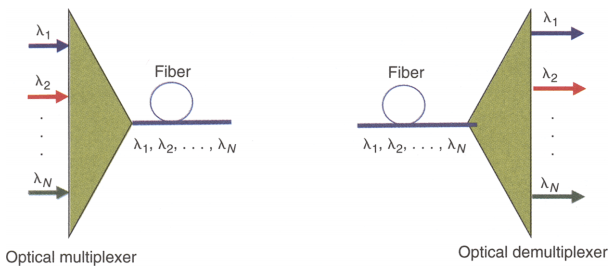
Figure 1: Components of a Traditional OADM
Configurations of OADM
There are two basic configurations of an OADM: using dielectric thin-film filter (TFF) and fiber bragg grating (FBG). For OADM configuration with TFF, an arbitrary signal wavelength is branched/dropped from wavelength-multiplexed signals via a narrow band-pass filter (BPF), whereby only the desired signal wavelength being transmitted while others reflected. Meanwhile, an arbitrary signal wavelength can be inserted/added into wavelength-multiplexed signals via a narrow BPF, whereby the desired signal wavelength being transmitted is combined with the reflected signal wavelengths.
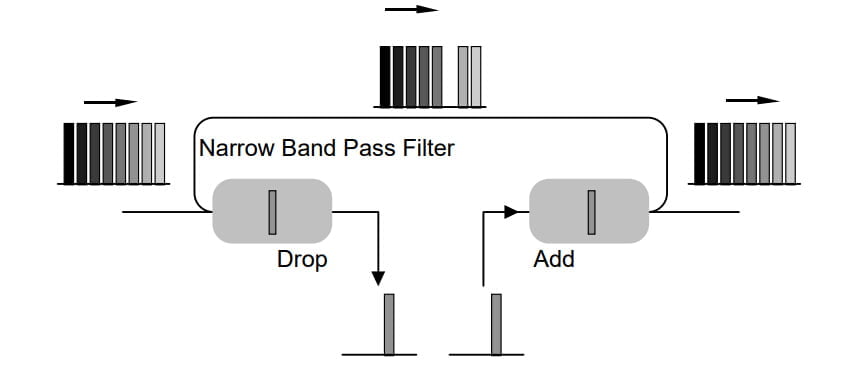
Figure 2: Configutation of OADM with TFF
While configuring an OADM with FBG, the wavelength-multiplexed signals enter an FBG through a circulator, where only one arbitrary signal wavelength is reflected while others are transmitted. The reflected signal wavelength is branched/dropped into a port other than that where the wavelength-multiplexed signals enter. In the case of wavelength multiplexing an arbitrary signal wavelength, the signal wavelength incident on the circulator is reflected by the FBG, and is inserted/added into the wavelength-multiplexed signals that are transmitted via the circulator.
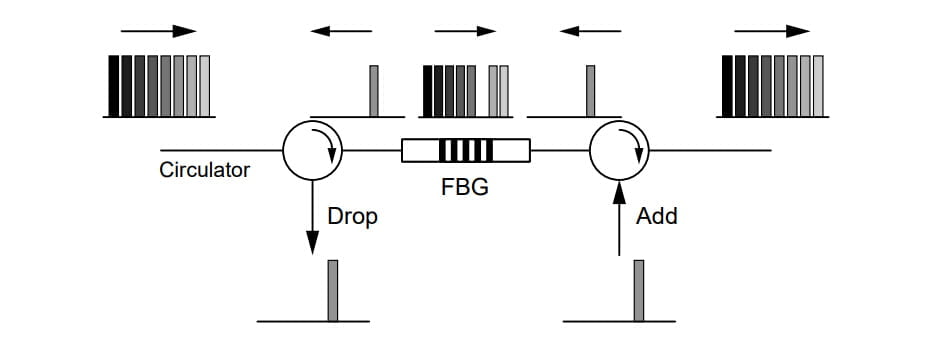
Figure 3: Configuration of OADM with FBG
Main Functions of OADM
As the name indicates, an OADM can add one or more new wavelength channels to an existing multi-wavelength WDM signal, or drop/remove one or more channels, passing those signals to another network path. The OADM selectively removes (drops) a wavelength from a multiplicity of wavelengths in a fiber, and thus separating the signals from the particular channel. It then adds the same wavelength in the same direction of data flow, but with different data content. OADM is commonly used in WDM ring systems and in long-haul for more flexible configuration and higher capacity.
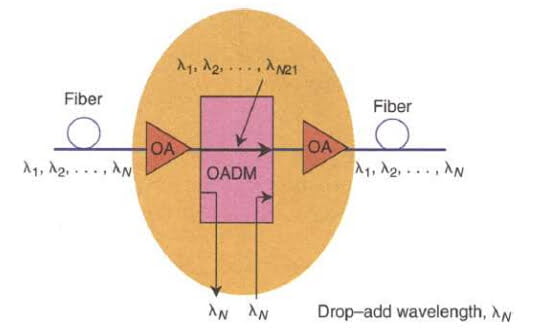
Figure 4: The Function of OADM
Different Types of OADM
OADMs are classified as FOADM (Fixed Optical Add-Drop Multiplexer) and ROADM (Reconfigurable Optical Add-Drop Multiplexer). In fixed-wavelength OADM, the wavelength has been selected and remains the same until human intervention changes it. In reconfigurable wavelength OADM, the wavelengths between the optical demultiplexer/multiplexer may be dynamically directed from the outputs of the demultiplexer to any of the inputs of the multiplexer.
Fixed Optical Add-Drop Multiplexers
FOADMs were originally developed to improve the delivery of “express” traffic through networks, without requiring expensive OEO regeneration. FOADMs use fixed filters that add/drop a selected wavelength “band” and pass the rest of the wavelengths through the node. Static wavelength-filtering technology eliminates the cost and attenuation to demultiplex all DWDM signals in a signal path. The solution is called FOADM because the wavelength(s) added and dropped are fixed at the time of add/drop filter installation on the optical path through a node. No additional filters can be added without interrupting express wavelengths traveling through the node.
Reconfigurable Optical Add-Drop Multiplexers
ROADMs were developed to provide flexibility in rerouting optical streams, bypassing faulty connections, allowing minimal service disruption and the ability to adapt or upgrade the optical network to different WDM technologies. It uses a Wavelength Selective Switch (WSS). The WSS has an 8-dimensional cross-connect and provides quick service start-up, remote cross-connect and WDM mesh networking. The ROADM scheme also allows inputting or outputting a single wavelength or wavelength group via the fixed port. In ROADM systems, we don’t need to convert the optical signals to electrical signals and route those signals by using conventional electronic switches then convert back again to optical signals just like FOADM does. ROADM can configure as required without affecting traffic.

Figure 5: The Principle of ROADM
Application of OADM
In conventional long-haul transmission systems, emphasis has been placed on how much capacity and how far the system can transmit. In metro/access networks, however, low cost and system flexibility are strongly required. OADM canverify both demands. The main battlefield of OADM application is in MAN (metropolitan area network), featuring high flexibility, easy upgrade and amplification. As an ideal multi-services transport platform in MAN application, OADM also allows different wavelength multiplexing signal at different locations. Another application for OADM is in Optical Cross Connection (OXC). Proposed equipment allow different network to connect dynamic, on-demand wavelength resources and a wider range of network interconnection. OADM and OXC only need to download the information in the nodes to send the person that handles the equipment, including ATM switchboard, SDH switchboard, IP router etc., which greatly improve the efficiency of the node to process information.
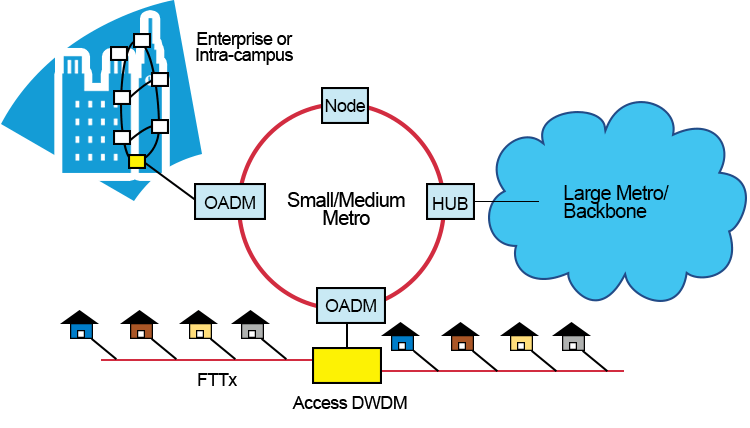
Figure 6: Application of OADM
Summary
To reduce the cost in large-capacity transmission, whereas conventionally most signal processing has been done after optical-to-electrical conversion, it is required to process signals in optical form. And OADM is one of the key devices to implement such optical signal processing. Use of OADM makes it possible to freely add or drop signals with arbitrary wavelengths over multiplexed optical signals by assigning a wavelength to each destination. Moreover, it also help simplify the component configuration of optical amplifiers through reduced optical attenuation for the express channels – optical channels neither add nor drop at nodes – in OADMs, thereby decreasing the total cost of networks. OADM is still evolving – although these components are relatively small, it will play a key role in producing compact, monolithic, and cost-effective devices.

Can you be more specific about the content of your article? After reading it, I still have some doubts. Hope you can help me.
how can I help?